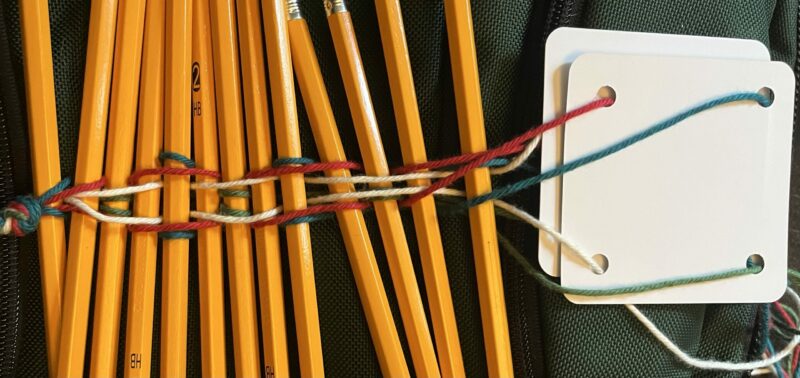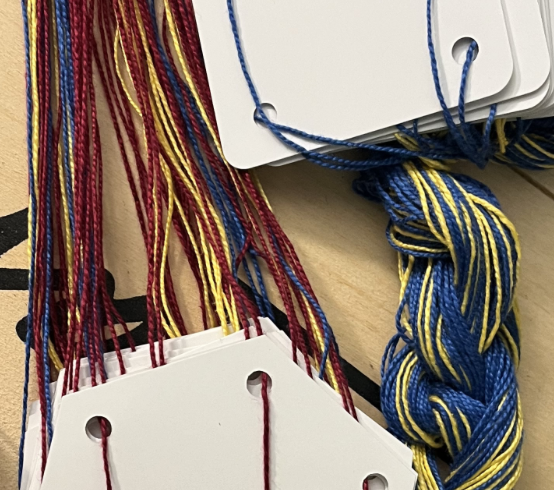I mentioned on a tablet weaving mailing list that I was teaching a five-day tablet weaving and sprang class. One of the readers asked what on earth goes into a five-day class, so I thought I’d post my outline. This could be a two-day class with experienced and knowledgeable participants, or a full five-day class all by itself (or considerably longer, if we explored all the ramifications and permutations). The outline isn’t something I fuss about, though: we cover as much or as little material as the students wish.
Look like fun? You can still sign up.
(Note: Not sure what’s up with the spacing, but don’t have time to fix it just now.)
Section A. Tablet Weaving
Part 1: Two-color Tablet Weaving
- Overview of tablet weaving
- Terminology
- Warp, weft, shed, pick
- Three kinds of tablet/card weaving
- Threaded-in patterns: warp twining
- Turned patterns
- Surface decoration: brocade, soumak
- Goals for the class
- Be able to set up your equipment
- Understand how tablet weaving works
- Be able to follow a written turning pattern
- Be able to design your own patterns in several techniques
- Playing with the big tablets
- S and Z threading
- Mixed threading doesn’t work
- Forward and backward turns
- First Law of Tablet Weaving: The thread that crosses the top is the one that shows.
- Second Law: An S-threaded tablet turned forward is the same as a Z-threaded tablet turned backwards.
- If and only if the color sequence is the same!
- Hole positions
- Why ABCD is a bad idea
- How to describe the hole positions properly
- Warp end / cloth end
- Top (face) vs bottom (back)
- Setup
- Equipment
- Tablets/cards: many options
- Tensioning device
- Warping
- Discontinuous warp – cut and thread
- Continuous warp – the fast way
- Selvage tablets: 2 on each side, turned all forwards
- Always a good idea, and required for many weaves
- Loom types
- 2 C-clamps; pegs in board; inkle loom;
- Using the frame loom
- Tying a bowline
- Tension adjustment
- Weaving basics
- New skill: turning the tablets
- New skill: making a secure beginning by weaving the weft end in
- New skill: leaving a weft loop to create neat selvages
- One pick == one pass of the weft
- Start: tablets all the same position, all S-threaded: horizontal stripes
- Note the twist in the cords: can’t make true horizontals but can make true verticals
- Warp twining
- Need to accommodate twist build-up
- Periodic untwisting; weights; swivels
- Switch to diagonals
- How to get the right diagonal?
- Experiment with turning forward and backward
- Don’t forget to look at the back of the band
- Switch to diamonds
- Check on getting right diagonals
- Experiment with turnings forward and backward
- New skill: making a secure ending by weaving the weft back in with needles or extra string loops
- Diagonal patterns (“Egyptian” diagonals)
- New skill: using two pattern packs
- Could also flip tablets
- Block patterns: changing four cards every four turns
- Don’t include selvages!
- Advanced version: change two tablets every two turns
- First pattern: start at left edge, work across
- Don’t include selvages!
- Second pattern: start at each edge, work to center and back
- Experiment as desired
- Double-face
- Overview
- Easiest way to draw pictures
- Fewest limitations on pattern types
- Drawback: blocky style, no smooth diagonals
- Weaving
- Tablets with color in same position
- Start with both dark threads on cloth end
- Can be SZSZ or all the same
- Use SZSZ here, as on pattern
- Turning sequence: FFBB, all tablets the same
- To change color, turn four time the same way: become out of synch
- Method 1: split into two packs, one going FFBB, the other BBFF
- Method 2: flip tablet, keep in same pack (Second Law)
- New skill: following patterns
- Bottom to top, so matches cloth growth
- One row represents one pick
- Each column is a tablet
- Pattern shows turning direction
- For doubleface, use brick graph paper
- Can shade in bricks to build pattern
- Work from sample pattern
- Pattern drafting
- Shade entire bricks; reverse turning pattern for those tablets
- 3/1 Broken Twill
- Overview
- Same turning pattern as doubleface: FFBB
- Tablets staggered – adjacent tablets not in the same position or turning the same way.
- Can have S-twill or Z-twill; direction must match diagonal color changes
- Weaving
- All tablets S-threaded
- New skill: reading the tablets
- Tablets start in different positions: need to look at pattern to figure out how to set them.
- Remember First Law of Tablet Weaving!
- Patterns
- New skill: following a turning pattern
- Slash for turning direction matches twist direction when tablets are S-threaded
- Forward slash / = forward turn
- Back slash \ = backward turn
- Pattern drafting
- Fill bricks to create a pattern
- Each tablet follows the FFBB sequence, but out of sequence with its neighbors
- Turns on either side of a color change must be in the same direction as that color change
- Both turns within a brick must be the same direction EXCEPT:
- You want to change the twill direction (change blocks in alternate tablets).
- Parallel color changes are separated by even numbers of blocks.
- Perpendicular color changes are separated by odd numbers of blocks.
Part 2: Two-hole Tablet Weaving
- Review from Part 1
- Questions?
- Differences between two and four holes
- 2 gives MORE possibilities because there are fewer constraints
- Harder to work with because of uneven support of tablets
- Adjacent holes or diagonal holes give different possibilities
- Play with giant tablets
- Warp twining – method 1
- Setup: diagonal holes, all tablets aligned
- Requires half-turns, not quarter
- Stripes and diagonals
- Note difference in angles
- Warp twining – method 2
- Setup: diagonal holes, tablets staggered
- Quarter-turns
- Plain weave
- FBFB
- No warp twining == warp-faced plain weave
- Andean pebble weave
- Overview
- History: used in the Andes, not traditionally tablet-woven
- “Pebbles” anchor floats
- Weaving
- Tablets all threaded S
- Tablets all start in same position: background color in top hole on cloth edge
- Quarter-turn back to bring up pebble color; quarter-turn forward to bring up base color
- No warp twining
- MUST keep hold of the tablets!
- Patterns
- Follow the pattern; turn appropriate color to top
- Make sure to use the correct turning direction
- Pattern drafting
- Pebbles all the same color
- Connect diagonally-adjacent pebbles by filling in the intervening pair
- Hochdorf pebble weave
- Overview
- Very early – European Celtic
- Weaving
- Tablets all S-threaded
- Tablets manipulated in pairs – ALWAYS
- Each pair turned FFBB; pairs alternate (next pair is BBFF)
- Background color in cloth-edge holes of first pair; warp-edge holes of second pair
- Patterns
- Condensed patterns: each square is two tablets and 2 picks
- Change color by turning a pair 4 times in the same direction
- Match slashes to color change; fixed sequence within solid areas
- Pattern drafting
- Direction of color changes must match turning direction
- Working from loom weaves
- Tablets threaded in adjacent holes
- Can create all possible sheds
- both up; both down; either pair of one up-one down
- Work through a weaving draft by pairs
- Check threading direction and right/left arrangement
Resources
General
- Collingwood, Peter. 1996. Techniques of Tablet Weaving. Robin and Russ. ISBN: 1566590558 (Paperback reprint)
- Crockett, Candace. 1991. Card Weaving. Interweave Press. ISBN: 0934026610 (Paperback reprint)
- Weaver’s Hand http://weavershand.com/
Double-face
- Linda Hendrickson’s books: http://www.lindahendrickson.com
- Staudigel, Ottfried. 2001. Tablet Weaving Magic. Books on Demand GmbH. ISBN: 3831113130
3/1 Broken Twill
- Guntram’s Tablet Weaving Page. http://www.guntram.co.za/tabletweaving/index.htm – patterns and software
Two-hole Patterns
- Banck-Burgess, Johanna. 1999. Hochdorf IV: Die Textilfunde. Konrad Theiss. ISBN: 3806214530
- van Epen, Marijke. 2002. The Unknown Tablet Weaving. Self-published.
- Kurt Laitenberger’s website
http://www.lindelwirt.homepage.t-online.de/tabtext.htm#tabletweaving






3 responses to “What goes in my weaving class?”
[…] What goes into my weaving class? Philia outlined it for us. And just a reminder that this is a dangerous time sink of a site. Love what she has here. […]
I have to admit to a bit of envy with people that can make tablet weaving work…
I read the directions in my books with great attention to warning and advice, I carefully lay out my threads, gingerly thread everything with assiduous attention to my threading diagram (I’m an old hand at loom weaving), and neatly tie off everything.
Then I start weaving…
after 2 turns, it’s a snarled mess, after 10 turns I throw my hands up in exasperation over the mangled mess I’ve made of such an easy craft…
My advice – take this class, learn everything you can and make friends with someone that knows what they are doing!
Yours,
Dughall-Eoghann LeGrannd
Shire of Spiaggia Levantina
Vivant Atlantia!
Thank you for sharing your class outline! The class looks amazing, and reminds me of how very much I still have to learn about tablet weaving. I wish I could take your workshop!